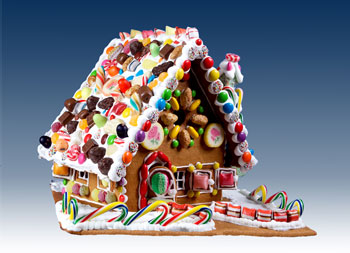 |
|
| Table of contents | |
| Beauty and the Beast | The Lady With the Mountain Hut |
| A Castle For Two | The “Extra-ordinary” and the “Personal” Christmas Present |
How to build a Gingerbread House |
|
Once more it was exhibition time again for our Gingerbread Houses Arts Presentation. It was first Advent, November, half past ten in the morning, a few visitors, no questions - it looked like a comfortable Sunday morning. A young man entered the exhibition, about six or seven years old, with his grandparents. I managed to draw back and observe the visitors. His way of scrutinizing the exhibition objects attracted my attention. First he looked at them from a medium distance, then he drew closer and closer, even ignoring our little cordon to come close enough to see how these houses were made. I could not understand what he asked his grandmother, but she looked around and then came up to me: Couldn’t I help her grandson with some explanations? Of course I was determined to stand the young man’s questions. At this point I had no idea that this would become a marathon of questions. He started out with the “normal” questions: “Did you build all these houses? How long did it take you? what do you do with all these houses? Why do you do all this?” etc. etc. When I thought I had pretty well answered all his questions to his best possible satisfaction, it turned out that this was only the beginning. “Can you tell me how I could fabricate a gingerbread house myself?” When he started this partition of questions I tried to get his grandmother involved to avoid the explanation of the preparation of the dough. But our young man wanted to find out by himself - and not only superficially. Why we started already in July with a kind of pre-dough, and why, and why, and why. Some questions later we had finished the topic “dough” and started deliberating on the issue of planning: Why do I have to imagine what the house will look like before I start constructing its parts? When starting out you need an idea, then you have to decide about the size and in the end you can draw a plan. This plan should be drawn directly on the cardboard from which the templates can be made which, laid on the rolled-out dough, facilitate the cutting of the houses different parts. Up to this point I had sought - with more or less success - to involve the grandparents. But now, that we entered the chapter of baking, we were completely left alone. The baked gingerbread pieces have to rest for at least one day before they get decorated with sugar icing - at this point our young friend gave up, realizing that his grandmother would prefer not to support him any more. I tried to by all means finish the building in his imagination. We somehow succeeded: After the parts have been decorated they will be glued together. First the main back wall has to be fixed on the ground plate. After the back wall the side pieces will be glued to it and then the front piece has to be carefully inserted. The most common roof consists of two parts. When we have managed to put them in place. The house has to dry for one night. It can then be finalized with roof and round-the-wall decoration. Finally the gingerbread house is ready for service as an Advent decoration piece or a delicious huge dessert. After almost two and a half hours of explanation and instruction I was convinced that back home his grandparents would bake and make a gingerbread house together with their grandson. I was soon taught something else: Our young man had chosen one of our exhibition models and revealed to me that he was not inclined to go through all that trouble himself. It was a good and successful sales talk. |
|
Beauty and the Beast |
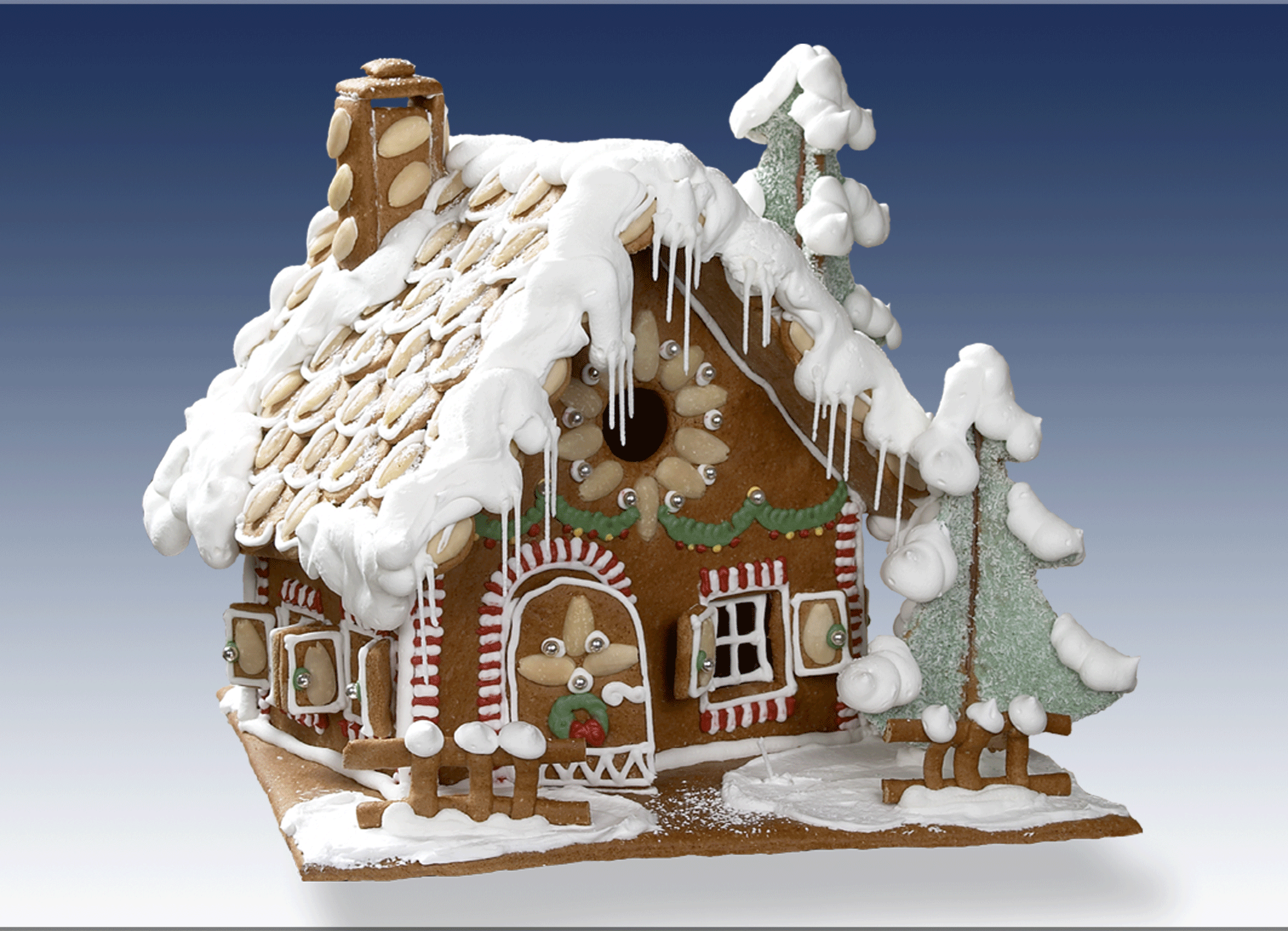 |
It was exhibition time once again in our gingerbread bakery. It was a rainy, gray day in November. A young couple entered our exhibition. She: an exceptionally pretty young woman with vivid, very cheerful eyes. He: a little grumpy with a three days beard and apparently not at all in the mood to see our gingerbread houses exhibition. In the course of looking at the exhibition she asked me several times meticulously how this or that was made and what was necessary to build these gingerbread houses. I willingly provided all necessary answers and could observe that her companion’s mood improved and that he also began asking questions. I noticed that she stopped several times in front of our “Almond House”, which she scrutinized very closely. Some time had passed before she told him: “I want the Almond House.” His riposte was blunt: “If you want a gingerbread house, set it up yourself. I won’t buy you one.” She: “But I want it.” He: “No, you won’t get it.“ This went on for a while until he very furiously stormed out of our exhibition. I assumed that he wanted to cool his temper with a glass of beer in our restaurant. Missed by far. He had run to his car and left - without his companion. This did not at all seem to bother the young pretty woman. She stayed and thus I learned that she actually was a trained cook. Her husband had told her that, if she wanted a gingerbread house, she would have to do it by herself. Since she did not live far away and I had some spare time, I drove her home. I presume that she was indeed pretty upset by her husband’s behavior. But I had the strong feeling that she would get her Almond House in the end. One week later the couple stood again in our exhibition and asked: “Do you still have this Almond House?“ We had. One. We wrapped it in paper, they payed and went off. My sense of human nature had not let me down. Two days later the pretty young woman was back again. She thanked me for driving her home the other day and told me the story: After I had seen her home she and her husband had a fierce quarrel. Finally she had given in and promised him to make her own gingerbread house - but under one condition: that he would clean up the kitchen. He agreed and they both went to work. When she took a packet of flour out of the cupboard to put it on the kitchen table, she dropped it halfway. The packet landed on the floor, exploded and half of the kitchen was white with flour. When her husband started to clean that up, she accidentally tipped the glass of honey which emptied into the cutlery drawer. A few minutes later she stumbled over the cleaning pail of her husband and spilled all the sugar which had been measured out for the dough. Things went like this all evening - at the end there was no gingerbread dough. Instead, kitchen and adjacent living room areas looked like a battlefield. Her husband had to work till late at night to keep his promise and tidy up. A few days later they gave it a second try. This time the gingerbread dough came out all right. But the electric kitchen stove broke down. I don‘t know how she did it. She never told. An electrician had to come and her kitchen received a new stove, which she had always wanted. There was never a third try. When she took the dough out of the refrigerator and wanted to start rolling it out, he took her by her hand, drove her to our exhibition and bought the Almond House which she had been longing for so many days. Hard to say who would be the „beast“ in this story. But it tells an example of how to get to your personal goal without necessarily quarreling. |
|
| A Castle For Two | 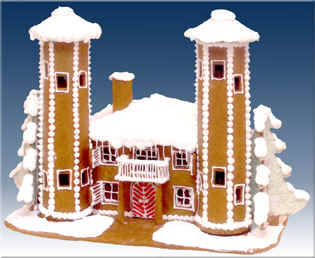 |
It was Christmas Time again and we were right in the middle of setting up our gingerbread design hous exhibition, when, one Thursday evening, just before closing time (7 p.m.), a young family entered Faberhof Manor and, proceededing towards our exhibition room, they shyly asked: “May we still take a look?” When we said “Yes”, the father told his two sons (twins, approximately 11 or 12 years old): “Go ahead, choose a house, but only one!” Without any further comment the family strolled through the exhibition room together , showing a considerable amount of interest, but after a while the two young masters left their parents and went to that corner of the exhibition room where we had placed our most work-intensive and elaborate gingerbread houses. The two boys looked at each other, nodded in tacit agreement and returned to their parents. So intensely were the latter occupied surveying the exhibition that the boys tried several times in vain to inform them of their decision. It was not before the end of their parents’ circuit tour that their father asked them: “Now, have you agreed on your pick?” “Yes” the boys answered unanimously, and when their father curiously asked them “Which one?” they pointed to that corner of the room with our most elaborate houses and said: “The Castle”. Their parents looked at each other, and, having a premonition as to the financial consequences, repeated, in order to make sure: “The Castle?” Again came the answer “The Castle”. Their choice was a wise one, because the castle had two towers, one for each of the twins. Their father turned to me and asked for the price. Since it was one of the houses meant for decoration purposes only there was no price tag. So I told him the price which made him somewhat ill at ease. Obviously, he had never planned to spend quite so much money on a gingerbread house. Therefore, he tried to sing the praise of another house to his sons, but the two stood firm. The family went into our restaurant to have a meal and asked if they might come back after dinner to take another look at the exhibition. When they returned from the restaurant their father tried again to change his boys’ minds. But, calmly and gravely, they reasoned with their father as follows: “You promised us that we may choose a house. You did not set any price-limit. And you did not tell us to choose a small house. All you said was ‘Go ahead, choose a house together’ but only one for the two of you.’ This is exactly what we did and we liked “The Castle” best. Would you now please keep your promise?” At this point their father became very pensive. When I offered to help and reduced the price, the parents decided to buy “The Castle” and give it to their sons. It was an exciting experience for all of us to watch these boys convincing their parents politely and calmly and how elated they were when they could finally take home their “Castle For Two” |
|
My Mother |
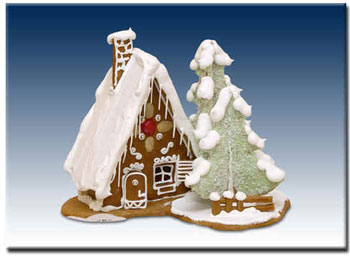 |
One early afternoon on December 8th, it may well have been the 8th of our exhibitions, in 2003, a couple came to visit the showroom, which was overcrowded at the time. I noticed them immediately because of their somewhat striking appearance: They were both rather tall and looked at the exhibits from above the other visitors. Like everybody else that afternoon they moved with the crowd. Suddenly the husband stopped dead in his tracks, turned around, tried to move against the stream, gently pushed other visitors aside, gained a few meters, and remained rooted to the spot. Other visitors tried to push him on again - but there he stood, a rock in a (slow) torrent. His eyes were fixed on one of our gingerbread houses. From where I stood I couldn’t see which one. After quite some time, it must have been more than 10 minutes, while his wife had already gained the kiosk with all the delicious gingerbread things to buy, he turned around and called her: “Maria, Maria, come and look, come to me!” He did not seem to care about the other visitors. His wife, aghast at his loud voice, turned around and tried to find a way through the crowd to get to her excited husband. When the gentleman turned towards his wife I could see his face. I was a bit concerned because I saw tears running down his cheeks. When his wife had managed to join him, he told her in a brittle but loud voice: “Maria, look, it was exactly a house like this that my mother made for me every year at Christmas when I was still a schoolboy.” He kept pointing at the little house in front of him. I could see now which of the houses he meant, giving rise, in turn, to quite some astonishment on my part. It happened to be the model I had built during my apprenticeship and had been allowed to put into the window of our shop, right next to the huge gingerbread house my master had produced that year. I, too, was quite touched. Later, when the tall couple took their cake and coffee in our restaurant, I told them the story of my first gingerbread house. And I was told the story of his mother’s gingerbread house. Of course it was not identical. There hadn’t been any trees at his mother’s house. But in other respects the houses looked astonishingly alike: There was an equal lot of snow on the roofs, the chimneys were the same, the doors stood wide open, they were both covered with almonds and had icicles. But the most important fact was that they had the same size. He told me, that, at first, he had not seen the house, but that, a few steps later, he had been “struck by lightening”, bringing back childhood memories. He did not notice all the other visitors around him any more. He was so full of a happiness and inner joy one would not have thought possible in a man of his status, responsible for several thousand employees. Of course he bought the little house and of course he asked me if I could build the house once more for him according to detailed instructions. The very next year he did receive his very special house and became a child again that wept for joy. His wife tried to calm him, to no avail. Finally, she gave up, took his car keys and drove him home - with his new house. The year after, there was no exhibition and we did not hear from him or his wife any more. I like to remember this incident, since it is one of the finest stories I was privileged to experience with regard to our gingerbread house exhibitions. |
|
Mountain Hut |
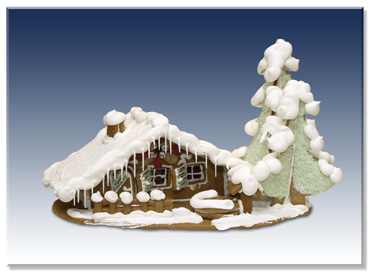 |
This story started in 1997 when our exhibition was already three years old. Shortly before the second Sunday in Advent we received a call in Emperor Franz’ Castle of Luberegg: A melodic female voice ordered a gingerbread house, the Mountain Hut. The aforsaid melodic voice arrived in a silver-colored Rolls Royce, accurately at 4 p.m. on the second Sunday of Advent, a chauffeur in fine livery opened the car door, a rather elderly, elegantly dressed lady youthfully rose from the back seat. She took a long and close look at our exhibition, sat down at a table in our restaurant and enjoyed her cake and coffee. Finally she went to the kiosk, picked up her Mountain Hut and left. Next year we got the same friendly phone call and watched the same pleasant procedure. When she had her cake and coffee we dared to ask her, why she did come now (we said. almost regularly) to buy the same Mountain Hut. This Hut with the fountain and the trees in front of it, she told us, reminded her so much of her childhood in Switzerland, where she had spent several summers with her mother. Besides, this little Hut fits so wonderfully on the mantelshelf of her living room. The ensemble really looks like Christmas, once the Mountain Hut had taken its place. The lady also confided to us what happened to the Mountain Hut after Christmas: On the day of the “Presentation in the Temple” (which is celebrated in Austria on February 2nd, it is the real end of the Christmas period) all her friends come to her to gather around a pot of glogg (mulled wine) to dip pieces of the Mountain Hut and “swallow” them. She told us that this was the most beautiful part of Christmas for her. She continued ordering her Mountain Hut, and when she came, regularly on the 2nd Sunday in Advent, to pick it up, we took an hour or so to listen to what had happened to her in the past year and at the last “swallowing of the Mountain Hut”. Her friends became fewer and fewer. In 2002 she told us that there had been only two of them left to “level the Hut to the ground”. But the amount of mulled wine had always been the same. Hadn’t there been any problems with the amount of wine? we asked. “Mr. Forstner”, the lady answered, “of course I was unbelievably drunk, but is was so beauuuutiful!” In 2003 there was no gingerbread exhibition. Many people had heard about the severe damages the great flood of the Danube had done to Luberegg Castle in 2002. Maybe this is why our “Lady with the Mountain Hut” did not call any more. We have never heard of her
again. |
|
the “Personal” Christmas Present |
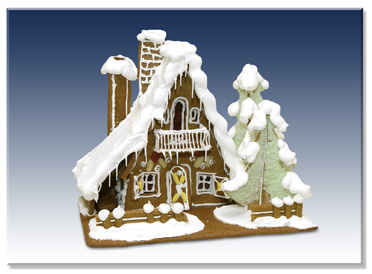 |
Let us revive an old custom practiced at the noble houses of Europe: They presented each other with the most astonishing gingerbread houses imaginable, as Christmas gifts during Advent season. Theses houses were decorated elaborately and sometimes even studded with genuine jewels, which made them really valuable. A “Confectioner at Court” had to be a real artist to meet the requirements and tastes of his sovereign. There were ornaments made of marzipan and silk sugar, there were sugar flowers and many kinds of confectionery. But the basic theme had to be visible through all this: the gingerbread house of Hänsel and Gretel. It is exactly that tradition or custom I would like to revive: Look for your personal Advent or Christmas present at our exhibition. Try to firmly imagine the receiver of this personal gift: What type of fellow citizen is she or he? What are his or her predilections, what hobbies does she or he have? You will be amazed how easily you can find the right house. Should it really happen, that you can’t find an appropriate house, don’t hesitate to ask advice from Peter Forstner, the artist. We would like to relate to you (in his own words) a personal Christmas custom of one our clients, an entrepreneur from the Northern part of Austria (the Waldviertel, the Quarter of the Woods), who turned up regularly every two or three years to buy gingerbread houses for his customers: “Before I found your gingerbread presents, we used to order huge expensive gift baskets for our best clients. One day a customer surprised us with an unexpected reaction that made us think. That gentleman handed the basket over to his secretary, asking her to distribute the contents among the staff. The following year we selected a medium priced gingerbread house for him. And then something very interesting happened when I drove up to him and presented him with the little house: He saw the little house, almost pulled it out of my hands and said: ‘This is for me only!’ He thanked us effusively for the wonderful present and his eyes beamed with joy. This incident initiated the idea to give, in due intervals, a select gingerbread house to our best clients. We had found the personal gift for showing our appreciation for good cooperation and growing business. We want to stick to this new tradition - and we do hope, Peter Forstner will have plenty of new ideas and enough models in his head to avoid repetitions. In addition, we nowadays ask him to add our company logo to each house we select. ”We are proud to be able to furnish the right houses for this customer again this year". What other present is there offering more facettes and possibilities than our gingerbread house? It looks great, smells great , tastes great, is sure to attract attention and is truly handmade, each house being a piece of art in its own right. In a nutshell: the ideal present for somebody who already has got everything. |
|
 |
|


